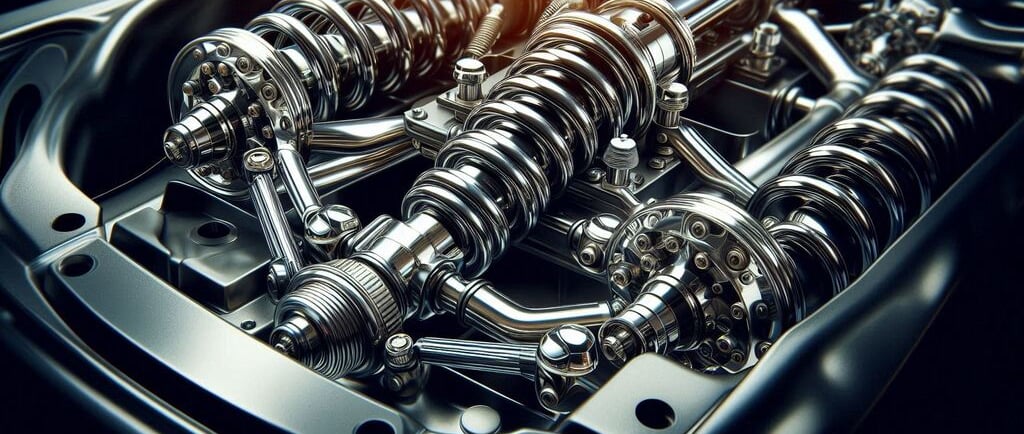Suspension Bushings
Have you noticed a rougher ride or strange noises when driving over bumps? You might think your suspension springs or shocks are the cause, but the issue could be your suspension bushings.
SUSPENSION PARTS
11/14/20244 min read


Suspension Bushings: What They Are, Why They Matter, and When to Replace Them
Have you noticed a rougher ride or strange noises when driving over bumps? You might think your suspension springs or shocks are the cause, but the issue could be your suspension bushings. These small but crucial components are key to keeping your drive smooth, safe, and comfortable. In this article, we’ll explore what suspension bushings are, their types, common signs of wear, and how to maintain them.
What are Suspension Bushings?
Suspension bushings are small rubber or polyurethane components that sit between metal parts in your suspension system, such as control arms, sway bars, and shock absorbers. They help cushion and reduce friction between these metal parts, absorbing vibrations from the road and enhancing vehicle stability. Essentially, bushings act as flexible connectors that make your ride smoother and quieter.
Key Functions of Suspension Bushings:
Vibration Reduction: Bushings absorb road vibrations, providing a more comfortable ride.
Noise Reduction: They help reduce noise from road impact and suspension movement.
Improved Handling: By holding suspension components firmly in place, bushings contribute to better handling and stability.
Types of Suspension Bushings
Not all suspension bushings are created equal. Here are some of the common types you’ll find in most vehicles:
1. Control Arm Bushings
Control arm bushings connect the control arms to the vehicle’s frame. They play a key role in absorbing impacts from the road, which helps improve handling and comfort.
2. Sway Bar Bushings
Sway bar bushings connect the sway bar to the frame, providing better stability when taking sharp turns. They reduce body roll and keep your vehicle more level on the road.
3. Shock and Strut Bushings
These bushings attach the shocks or struts to the vehicle, dampening the impact from the road. They contribute to ride quality by reducing the transmission of road impacts to the vehicle's frame.
4. Trailing Arm Bushings
Trailing arm bushings are typically found in the rear suspension. They keep the rear wheels aligned with the car’s body, improving stability and reducing rear suspension noise.
Each type of bushing serves a unique function, working together to ensure a comfortable and controlled driving experience.
Signs Your Suspension Bushings May Need Replacement
While suspension bushings are durable, they don’t last forever. Exposure to moisture, dirt, road salt, and temperature changes can cause them to deteriorate. Here are some common signs that your suspension bushings may need attention:
1. Clunking or Rattling Noises
Worn or damaged bushings can produce clunking or rattling noises, especially when going over bumps or making sharp turns. This noise happens because worn bushings allow metal parts to come into direct contact, creating that unpleasant sound.
2. Vibrations in the Steering Wheel
If your steering wheel vibrates more than usual, worn suspension bushings could be the cause. Damaged bushings can’t fully absorb road vibrations, which may transfer to the steering column and, ultimately, your hands.
3. Unstable Handling
Worn bushings lead to looser connections within the suspension system, which can make your car feel less stable. You might notice increased body roll when cornering or even a pulling sensation in the steering.
4. Uneven Tire Wear
Suspension bushings help keep your vehicle aligned, and when they’re worn, your wheels may no longer sit correctly, causing uneven tire wear. Regularly checking tire tread for wear patterns can help you identify suspension issues early.
Maintaining and Replacing Suspension Bushings
Maintaining suspension bushings helps extend their lifespan and ensures a smoother, quieter ride. Here are some practical tips for keeping your bushings in top shape.
1. Regular Inspections
Routine inspections are the best way to monitor bushing condition. Look for cracks, signs of wear, or deterioration in the rubber or polyurethane. Many auto shops will check these as part of regular maintenance.
2. Proper Lubrication
Some bushings, especially those made of polyurethane, benefit from occasional lubrication. Using a bushing-friendly lubricant reduces friction and wear, extending their life.
3. Timely Replacements
Replacing worn bushings promptly can prevent more expensive damage to the suspension system. While some bushings are inexpensive, labor costs for replacement can vary depending on their location in the suspension. Failing to replace worn bushings can lead to additional issues, including alignment problems and premature wear on other suspension parts.
4. Use Quality Parts
When replacing bushings, opt for quality OEM (original equipment manufacturer) or reputable aftermarket parts. This can ensure a longer lifespan and better performance. Rubber bushings provide a softer, more comfortable ride, while polyurethane bushings are more durable and provide improved handling for performance-oriented drivers.
Why Suspension Bushings Matter for Safety
Safety is a top priority when it comes to vehicle maintenance, and suspension bushings contribute to it. By keeping the suspension components properly aligned and stable, bushings improve handling and control. A car with worn bushings may be harder to control, especially in sudden maneuvers or on rough roads, increasing the risk of accidents.
For this reason, regular inspection and maintenance of suspension bushings aren’t just about comfort—they’re about keeping you and your passengers safe on the road.
Conclusion: Keep Your Ride Smooth with Proper Suspension Bushing Care
Suspension bushings might be small, but their role in your vehicle’s performance and safety is substantial. From reducing noise and vibrations to improving handling and stability, bushings help deliver a safe, comfortable ride. Recognizing the signs of wear—like clunking noises, vibrations, and unstable handling—can help you stay ahead of potential suspension issues.



